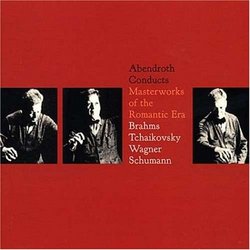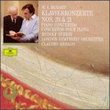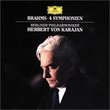| All Artists: Abendroth Title: Abendroth Conducts Masterworks of the Romantic Era Members Wishing: 0 Total Copies: 0 Label: Music & Arts Program Release Date: 1/19/1999 Genres: Pop, Classical Styles: Vocal Pop, Opera & Classical Vocal, Forms & Genres, Concertos, Serenades & Divertimentos, Instruments, Strings, Symphonies Number of Discs: 2 SwapaCD Credits: 2 UPC: 017685103827 |
Search - Abendroth :: Abendroth Conducts Masterworks of the Romantic Era
 | Abendroth Abendroth Conducts Masterworks of the Romantic Era Genres: Pop, Classical
|
Larger Image |
CD DetailsSimilar CDs |
CD ReviewsAbendroth's Musical Abendland Thomas F. Bertonneau | Oswego, NY United States | 10/02/2000 (4 out of 5 stars) "Hermann Abendroth (1883-1956), like his almost exact contemporary Wilhelm Furtwängler, mostly confined himself to the classics of the Austro-German tradition: Bach, Haydn, Mozart, Beethoven, Schubert, Schumann, Wagner, Brahms, and Bruckner, with occasional forays into Tschaikovsky, Reger, Mahler, and a few other, conservatively "modern," composers of the first half of the century. Unlike Furtwängler, who remained stubbornly in the public consciousness after his death (at the too-young age of sixty-eight) in 1954, Abendroth faded from public view, except outside East Germany, after the war and has only in the last decade been rediscovered by music-lovers. He came to renewed public attention a few years ago when Tahra released his readings of Bruckner 7 and 8 in a two-disc set, and since then a spate of his recordings, from the late 1920s up through the year of his death, has found its way into the catalogues. Most of these appear on Tahra (and are worth investigating); but Music & Arts has contributed with a two-disc set featuring Schumann 1 & 4, the Brahms Serenade in D Major, Wagner's Wesendonck Lieder, and Tschaikovsky's Rococco Variations. The sources are from former East German State Radio archives and date from 1951-56. Why bother? as the jaded might ask. Anyone interested in his first or in a new performance of, say, Schumann's Fourth will certainly do better by a modern, stereo recording. This is partly true, but only partly. The DDR tapes represent what was probably state-of-the-art in their day. They are a high-fidelity medium that give a sharp sound-picture and convey many subtleties. The absence of stereophonic sound should prove less of a disappointment than audiophiles would think. But it is the interpretation that makes these documents attractive. Abendroth infuses the two Schumann Symphonies with much elan: The beginning of the Fourth, for example, with its tympany roll and low groan in the orchestra, is made to prognosticate the beginning of the Brahms First; the Romanza is played, on the other hand, truly like one of Schumann's songs, an orchestral song-without-words. The opening of the First Symphony is again masterfully calculated and the propulsive main subject becomes a kind of roller-coaster ride. To invoke a cliche: "They just don't play it this way anymore." And that, more than anything else, is the reason for investigating Abendroth. He makes familiar music fresh because he approaches (or rather approached) it in a gutsy, subjective manner that has, alas, all but disappeared from contemporary music-making. This M&A set is a good place to start."
|

 Track Listings (10) - Disc #1
Track Listings (10) - Disc #1



